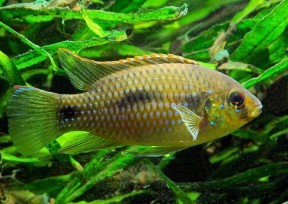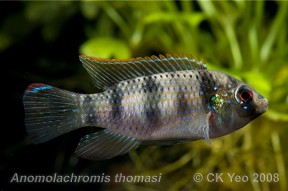Anomalochromis thomasi
African Butterfly Cichlid, Afrikanischer Schmetterlingsbuntbarsch (DE)
SynonymsTop ↑
Paratilapia thomasi Boulenger, 1915
Etymology
Anomalochromis: from the Latin anomalos, meaning ‘abnormal, irregular’, in reference to the unusual preopercular-mandibular lateral-line canal, which lacks a passage through the anguloarticular bone, and chromis, meaning ‘a marine fish’ (possibly the Shi Drum, Umbrina cirrosa) and often used in the naming of African cichlid genera following the description of Chromis (currently Oreochromis) mossambicus Peters, 1852.
thomasi: named for British anthropologist Northcote W. Thomas (1868-1936), who collected the type series.
Classification
Order: Perciformes Family: Cichlidae
Distribution
Sierra Leone, Guinea and Liberia.
Habitat
It inhabits forest streams, characterised by large amounts of overhanging vegetation. The water is often tea-coloured, being heavily stained with tannins from decaying organic matter.
Maximum Standard Length
70 – 80 mm.
Aquarium SizeTop ↑
A tank with base dimensions of 80 cm x 30 cm is adequate for a small group.
Maintenance
The aquarium should contain flat rocks to act as spawning surfaces and plenty of hiding places. Clay pot caves, roots and pieces of driftwood can all be used. Plants aren’t essential but the fish will appreciate the additional cover. In fact, this species makes an ideal choice for the planted tank, as it won’t dig up the substrate.
Water Conditions
Temperature: 23 – 27 °C
pH: 5.5 – 7.5
Hardness: 18 – 268 ppm
Diet
Unfussy and will accept most foods. A good quality cichlid pellet can be fed as staple, but ensure the diet is kept varied with regular feedings of live and frozen foods.
Behaviour and CompatibilityTop ↑
Very peaceful for a cichlid, but is territorial when spawning. Don’t be tempted to keep it with very vigorous species as thomasi is a shy and retiring little fish. Good tankmates include small characins, other African dwarf cichlids, Corydoras spp. and smaller anabantoids.
This species is loosely gregarious and best maintained in a small group.
Sexual Dimorphism
Males are larger than females and tend to have less distinct black markings. Females are noticeably round in the belly when full of eggs.
Reproduction
Easy. Substrate spawners. A single pair can be bred in a 24″ aquarium, with a larger tank being required for 2 or more pairs. Unlike many West African dwarf cichlids, it’s suprisingly unfussy regarding water chemistry and will breed in both slightly acidic and slightly alkaline conditions. Gentle filtration via an air-powered sponge filter is adequate. Provide plenty of flat stones and broad-leaved plants such as Echinodorus sp. to act as potential spawning sites.
As with most cichlids, the best way to obtain a pair is to buy a group of 6 or more young fish and grow them on together, allowing pairs to form naturally. Condition the group on a high quality diet of frozen and live foods. You may also wish to add a group of small characins or similar to act as dither fish. Pair formation is fairly obvious when it happens, as the fish are monogamous and a pair will be seen defending their territory from intruders.
When ready to spawn, the female will clean a number of potential sites on flat rocks and broad plant leaves around the territory of the male. The male will then join her in cleaning a single selected site. Spawning occurs in a similar fashion to many other cichlids, with the female laying a line of eggs before moving away, allowing the male to take her place and fertilise them. Up to 500 eggs may be fertilised in this manner. The eggs hatch in around 48 hours, and during this period the male will defend the spawning site while the female tends to the eggs. Some role swapping may occur here. Also during this period the pair dig a number of shallow depressions in the substrate around the spawning site.
Once the eggs have hatched, the entire brood is moved into one of these pits. They will usually be moved several times before they become free swimming, which generally occurs after a further 72 hours or so. Unusually, once the fry become free swimming it takes around another 12 hours for them to completely use up their yolk sacs. At this point they can be fed microworm and/or brine shrimp nauplii. Brood care by the parents usually continues for about a month, after which they may spawn again. The fry are quite slow-growing.
NotesTop ↑
Often overlooked when seen for sale, as juveniles can appear a little dull, A. thomasi is actually one of the best choices for the newcomer to dwarf cichlids. It is relatively undemanding, peaceful, easily bred and quite beautiful once settled into the aquarium.
The genus is currently monotypic, although several colour forms are available from time to time. In the future some or all of these may prove to be distinct species.





